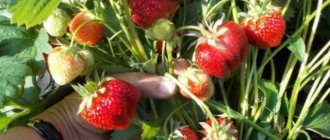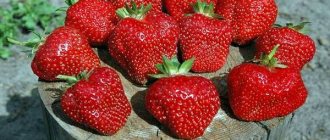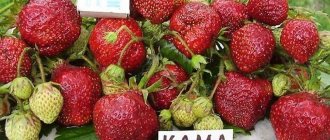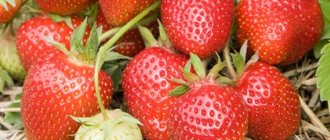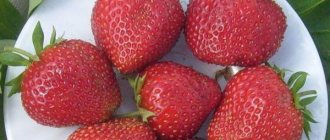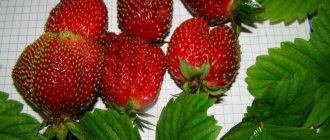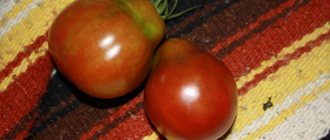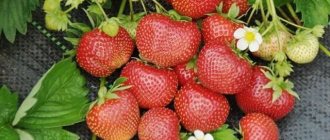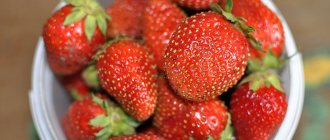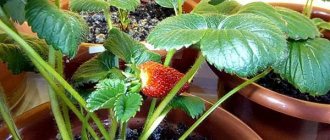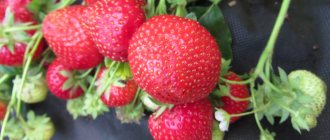Among the early-ripening varieties of strawberries, one cannot fail to note the Honey variety, created by American breeders in the 70s of the last century. Obtained by crossing the well-known varieties Holiday and Vibrant, the daughter form inherited the best features of its “parents”: large berries and high yield. The “American” appeared in Russia in 1979 and since that time has found many admirers among our compatriots.
Description of the variety
Bushes
The upright Honey strawberry bushes are large and well-leafed. The large, three-lobed leaves are medium wrinkled and ribbed. The leaf blade is concave in shape with pubescence, colored dark green.
Thick peduncles are located below the level of the leaves, their number does not exceed 5-8 pieces. The root system is strong and well developed. Honey produces many tendrils that grow after fruiting, which is convenient for breeding the variety, while the plant does not waste energy on rosettes during the formation of berries.
Honey begins active growth in April, and produces a harvest at the end of May: up to 15 flowers are formed on each bush. The berries ripen together: fruiting lasts no more than 2-3 weeks.
Berries
The fruits of the Honey variety have the following characteristic features:
- weighing up to 25-30 g (first collection);
- dark red, almost burgundy color;
- characteristic glossy shine;
- juicy and elastic pulp;
- wine-sweet taste;
- bright aroma.
The berries are distinguished by their uniform color, rich taste and delicate aroma. These characteristics are expressed most clearly at the end of fruiting. Honey bears fruit once per season; already in June, fruiting ends and active formation of whiskers begins.
Note: To speed up fruiting and get an extra-early harvest, immediately after the snow melts, cover the strawberry bushes with agrofibre. Fruiting will begin earlier and will be more active.
Productivity
The Honey variety bears fruit quickly and for a short time, so the berries must be picked every 2-3 days. In 2 weeks, the “American” will give away the entire harvest. Experts estimate the yield as average: up to 400 g per bush, on an industrial scale up to 146 c/ha (single-belt scheme), 126 c/ha (multi-belt scheme).
History and characteristics of the variety
The Honey variety is no longer new to the market. It was bred in 1979 in America; it has been known to gardeners for a long time, but was registered in the State Register of Breeding Achievements only in 2013. Many years of research on the variety were carried out at the North Caucasus Federal Scientific Center for Horticulture, Viticulture, and Winemaking, after which this plant was recommended for cultivation in the Central, Central Black Earth and North Caucasus regions of Russia.
Honey strawberry bushes are distinguished by straight, powerful stems and large leaves.
Honey bushes are erect and powerful, with dark green leaves without shine. The berries have a conical shape, with a neck. Juicy pulp has a sweet and sour taste, without aroma.
The large fruits of the Honey strawberry have a rich color and a well-defined neck
If you are going to read about this variety in the State Register, do not look for the “strawberry” plant, it is not there. Both Honey, and Festivalnaya, and the well-known Zenga Zengana are varieties of garden strawberries, and “strawberry” is just a colloquial name for delicious berries that has deeply entered into everyday life.
Since the honey strawberry was obtained from two selected varieties - the mid-season, but very productive American Holiday and the early-ripening British Vibrant, it inherited the best qualities of both “parents”. This variety has the following positive characteristics:
- Early ripeness. The first fruits appear at the end of May (the further north the planting is, the later; the period can vary within 1–2 weeks), the yield of fruits is uniform, lasting about half a month or a little more. Plants bear fruit once per season.
- Large fruit. The berries weigh on average 16–18 g, but larger ones are also found, up to 30–35 g, especially in the first and second years of fruiting.
- High yield - up to 400–500 grams of berries per bush or 105–115 kg per hundred square meters. The fruits are formed in clusters of 10–12 pieces.
- The berry pulp has a dense consistency and, as a result, good shelf life and transportability. Some gardeners note that Honey can be stored in the refrigerator for up to a week, that is, from one weekend trip to the country to the next, productive bushes will provide you with fresh berries. This is the advantage of this variety over sweeter and softer ones.
- High resistance to negative environmental factors. The variety tolerates both winter frosts (you don’t need to cover it in winter in the southern regions), as well as drought and heat, since it forms a powerful bush with a rich, large rosette of leaves and developed roots.
- Versatility of use. From these strawberries you can prepare a wide variety of winter supplies: preserves, jams, compotes. The latter will be perfectly stored and will not become overcooked due to the presence of acid in the fruits, as well as due to the good density of the berries.
Dense Honey berries will remain intact in jam
The most frequently mentioned disadvantages of the variety are:
- The tendency of bushes to be affected by verticillium wilt.
- Sour taste of fruits. There is an explanation for this: the berries contain a very large amount of vitamin C (67.6 mg per 100 g of fruit), so they are extremely useful when eaten fresh.
Video: Honey strawberry harvest ripens
a brief description of
Advantages of the variety
- early harvest;
- fruits do not wrinkle during transportation;
- bushes are resistant to frost, heat and drought;
- good immunity to diseases (powdery mildew, spots).
Disadvantages of the variety
- quick harvest (fruiting lasts only 2 weeks);
- excess moisture in the soil is destructive;
- tendency to diseases of the root system;
- Long-term storage leads to loss of commercial quality.
Note: Honey strawberries are ideal for business due to their early ripening, friendly yield, uniformity and aesthetic appearance of the berries. Thanks to the abundance of mustaches, the variety can be quickly bred on an industrial scale.
Description of strawberries Honey
This crop is harvested once a year, but the berries ripen early, and the yield itself is high.
The plant has good ability to transport, high frost resistance (it can be grown even in regions with harsh climates) and immunity to diseases.
General information about culture
The berries of this variety have a very pleasant smell.
- The outside of the strawberry is bright red and shiny, but inside it has red, sweet and sour pulp.
- The berries are large, weighing up to forty grams.
Plus berries - they can be consumed in any form: fresh, in jam, juice, compote.
The variety takes root well, grows and bears fruit in any type of soil, but black soil is the best choice for planting Honey strawberries.
Strawberry variety Honey
The downside is sensitivity to moisture levels.
If there is an excess or lack of moisture in the soil, this can lead to rotting or disease of the roots.
Landing
Autumn planting is more suitable for the Honey variety. Fruit buds are laid at the end of summer; bushes planted in autumn will begin to bear fruit in the spring. The main thing is to plant about a month before the first frost so that the seedlings have time to take root. It is even better to plant in the second half of summer, so that the bushes not only take root, but also have time to get stronger and form.
Planting material must meet the following requirements:
- 4-5 leaves without spots or deformations;
- elastic, dense roots;
- root collar up to 1 cm thick.
Bushes affected by mites are discarded. Long roots and wilted or diseased leaves are trimmed.
Strawberry Honey grows best on black soil, but loamy and sandy loam soils are also suitable for it. Slight acidity is allowed. Organic matter can be applied either point-by-point, under each bush, or throughout the entire area at once. A continuous covering of rotted manure, in addition to its nutritional function, will serve as mulch, preventing the soil from drying out.
A flat, evenly lit area is selected for planting strawberries. The following planting scheme is suitable for the variety: 30 cm between bushes and 0.5 m between rows. The depth of the holes is about 10-12 cm.
It is advisable to plant in the evening. The roots of the seedling are carefully straightened and the rosette is buried at the level of the root collar, without covering the growth points with soil. Then watering and mulching are carried out. It is convenient to plant bushes with a closed root system, in which the root system is transferred with a clod of earth and the roots are not injured.
Note: Along the edges of the beds and between the rows, planting lettuce, spinach, parsley, and carrots is useful. The presented crops improve the growth of strawberries. And onions, garlic and marigolds can repel pests.
Advantages and disadvantages
Strawberries have a number of advantages and disadvantages. Among the positive aspects it is worth highlighting:
- Good commercial quality.
- High yield.
- Resistance to superficial diseases.
- The berry retains its presentation for 3 days.
- High frost resistance.
The disadvantages of the variety include:
- With high humidity, the berries begin to rot and lose their taste.
- During long-term storage, the fruit becomes black and loses all its juiciness.
- The plant is vulnerable to diseases of the root system.
Growing and care
Watering
Strawberries of the Honey variety are sensitive to heavy watering. Excessive moisture can lead to various root rots. After planting, young rosettes are watered daily for a week, and then the number of waterings is reduced to once every 7-10 days. On large plantations, it is convenient to use drip irrigation, which allows you to evenly wet the soil at a given frequency.
The variety is tolerant of drought, but it should not be prolonged. In the absence of watering during the fruiting period, the yield falls and the berries become smaller. Mulching the soil with peat or straw in a layer of up to 10 cm will help reduce the number of waterings.
Loosening, weed control
Loosening and weed control are carried out throughout the growing season. The plantations should not be allowed to become overgrown with weeds, which thicken the strawberry plantings and take away some of the nutritional components.
Loosening is necessary to ensure access of moisture and air to the roots. This technique allows you to remove the soil crust that forms on the surface and also reduce the number of weeds. When mulching, frequent loosening is not necessary.
Removing a mustache
The peculiarities of the Honey variety include the formation of mustaches after fruiting. This allows them to be removed after harvesting. Removing the whiskers is a mandatory procedure, allowing the plant to remain strong and viable and gain strength for fruiting next year. The whiskers are removed gradually, as they grow, be sure to be cut off and not pulled out, so as not to injure the bush.
Top dressing
Strawberry Honey is responsive to fertilization. Three main feedings are carried out:
- in the spring, add an infusion of mullein (1:10) or urea (1 tablespoon per bucket of water), which enhances the growth of green mass;
- during fruiting, complex mineral supplements (according to instructions) are useful, since during this period strawberries need a combination of a number of different nutritional components;
- in September, so that the bushes overwinter well, phosphorus-potassium mixtures are added.
Note: During the summer, adding organic matter and ash is useful. Ash can be applied in dry form so that it gradually releases microelements into the soil, or an ash infusion can be prepared.
Pest and disease control
Strawberries of the Honey variety are “indifferent” to many diseases, but are often affected by Verticillium wilt of the roots. This is a fungal disease that can occur gradually and secretly and is manifested primarily by slower growth of bushes and a decrease in yield. The fungus spreads in the soil, attacking healthy plants.
Honey has low immunity to gray rot. The disease actively manifests itself in dense plantings and in rainy, damp summers. The fungus parasitizes berries, which are covered with a gray, fluffy coating.
Of the pests, the Honey variety is most often affected by aphids and spider mites. The berries are damaged by slugs, but this is typical for any variety.
Preparing for winter
In autumn, the bushes are cleared of old, diseased leaves, leaving 5-6 young ones. The overgrown mustache is removed and the “heart” or central part is checked, where next year’s buds are formed. It is important that they remain intact.
Strawberries Honey can withstand frosts down to -18 C, so in the middle zone during winters with little snow they need shelter. The bushes must be mulched and covered with leaves, and on top with spruce branches or non-woven material.
Diseases and pests
To combat verticillium, the following measures are used:
- Water the plants at the roots with a 0.2% solution of foundationazole. Only uterine bushes are treated in this way.
- Digging up and destroying infected plants.
- Growing lupine or mustard as strawberry predecessors.
To cope with aphids, you need:
- Spray the bushes with a 6% solution of laundry soap.
- Treat the plants with a decoction of garlic and onions, prepared at the rate of 200 ml of garlic juice, the same amount of onion juice, 150 ml of dandelion juice per 10 liters of water.
- Collect pests by hand.
To destroy the strawberry mite, you should follow these rules:
- Warm up the seedlings to +50 degrees before planting.
- Spray the bushes with a solution of colloidal sulfur or karbofos at the rate of 8 g per bucket of water.
- In advanced cases, increase the dosage of drugs by 15%.
To destroy the nematode, the following measures are used:
- Dip the seedlings in water at a temperature of +60 degrees, then spray them with ice water immediately before planting.
- Marigolds are planted next to strawberries, which pests cannot tolerate.
- Infected bushes are isolated or destroyed along with the soil on which they grew.
Reproduction
Strawberries bear fruit for 4-5 years, after which the plantation needs updating. For the Honey variety, propagation is used:
- Usami. To do this, leave 1-2 mother plants, from which flower shoots are removed. The mustaches are pinned down so that they do not “spread”, and after rooting they are planted in separate containers. It is better to use 1st order mustaches, they are stronger and more viable.
- Dividing the bush. An old 3-4 year old bush is renewed by separating the lateral daughter bushes with fresh foliage from it, and the central part is removed.
- Seeds. The method is rarely used, as it is very labor-intensive. Strawberry seeds are small and it will take a lot of time to get full-fledged bushes. This is not necessary if there is significant whisker formation.
Reviews from gardeners
Many gardeners who have already appreciated the berries leave reviews about this variety of strawberries:
Margarita: “The Honey variety is unpretentious, but at the same time gives a good harvest. The berries are juicy, sweet, suitable for freezing and jam.”
Angelina: “In the first year I harvested a small harvest, then I started applying only organic fertilizers. Now there are a lot of berries, they look aesthetically pleasing, and everyone in my household likes the taste.”
Nikolay: “I’ve been growing strawberries for many years, I like this variety more than others. There are a lot of berries, and the bushes look neat. The first harvest produces large fruits with a pleasant sweet and sour taste. Then the berries become smaller, there are fewer of them, but they are much sweeter. I like these much better.”
Reviews
I really like the early ripening periods in Honeya. Already at the end of May I am with strawberries, Zenga Zengana begins to bear fruit only after 10 days. The berries are large, sweet and sour, aromatic, juicy, however, you need to wait for them to fully ripen and become dark red, otherwise you will feel a clear sourness. I don’t sell the berries, but for those who are looking for a variety specifically for sale, I will say that they should look for something else - a fully ripened “Honey” does not last long and quickly loses its appearance.
Got rid of Honey. For several years in a row, flowers are affected by return frosts. Probably a variety for more southern regions, and I live in the Urals. Here you can either cover it with something or plant remontant or late varieties.
“Honey” is large-fruited and early, but I don’t like the taste - it’s sour. It is capricious when it comes to watering (it does not like stagnant water, but it also has an extremely negative attitude towards dry periods), and is also susceptible to verticillium.
Strawberry Honey belongs to reliable, time-tested varieties of early ripening. It bears fruit well in mid-latitudes, and under cover it produces early harvests, which are in demand both for personal consumption and for market sales. After all, how great it is when, after a long, cold winter, you have the opportunity to replenish your supply of vitamins with the help of tasty and aromatic strawberries.
Description of fruits
Honey is not a very large variety. The berries of the first harvest, on average, reach 20 g. When all agrotechnical measures are carried out, they can grow up to 30 g. Subsequently, the fruits become smaller, their average weight is 15 g. But the aroma and taste become more intense.
The shape of the strawberry is cone-shaped, the color is bright red with a glossy sheen. The pulp is dense, juicy, pink in color. The taste is sweet and sour. The level of sugar content is 5.7%, and acid content is 0.87%. According to professional tasters, the taste quality is rated 4.6 points out of 5.
There is a high content of vitamin C - 67.6 mg/100 g, so strawberries are recommended to be consumed fresh. Also, blanks are made from it and frozen in the freezer. During transportation, the fruits do not deteriorate and do not lose their presentation.
Proper care
In order for the plants to take root in the first week, watering is carried out once daily. After this you will need to do this once a week. In hot weather, increase the frequency of watering to once every 5 days. It is better to water in the morning or evening, when it is not hot. When the flowering period begins, the plant needs to be watered at the root; before that, you can use the sprinkling method.
For additional nutrition, fertilizing and loosening of the soil are carried out once every two weeks. Regular checking of the land for weeds and their removal is also required.
During the period of new leaves appearing and flowering in spring, it is useful for plants to receive fertilizing in the form of a mixture of 500 ml of ash and 1 tablespoon of urea or various mineral fertilizers.
Propagation of the Honey variety
The Honeoye variety grows and bears fruit for four years, so the plant simply needs regular propagation. The most common and easiest way is with your own mustache. Select bushes with the best characteristics and plant them away from fruit-bearing crops. Don't forget to remove the stalks. In order for a high-quality seedling to grow, you need to leave no more than three or four tendrils on one plant.
In order for the seedling to be of good quality and to carry the properties of the mother bush, it is necessary to monitor the length of the mustache, cutting it off after the first bush that appears. Separation of the seedling from the mother plant occurs when they overwinter. The seedling will be quite developed, with a good root system. In order to get a lot of planting material, you need to leave several young plants on one runner. They will develop a little slower, but then they will still gain strength.
Some gardeners do not like to bother with the mustache, preferring the method of dividing the bush. With this technique, the plant must be removed from the ground, the roots thoroughly washed, and carefully, trying not to damage, divided into several identical parts. Usually this method is suitable for varieties that do not produce whiskers. Honey is not one of these, because during the fruiting period it produces abundant growth.
In order for garden strawberries to maintain high yields, they must be replanted every four years. It’s good if turnips, radishes, garlic, onions, herbs (parsley, dill, green onions), bulbous flowers or marigolds previously grew in the new place. But the best predecessor is some kind of green manure: mustard, rapeseed, buckwheat. When they fade, they should be buried in the ground. You should not plant the crop in an area where crops such as potatoes, eggplants, peppers, zucchini or pumpkins previously grew.
Recommendations for planting
The first step is to choose the right place to plant. The choice determines whether you get a decent harvest or not. A light southern slope, protected from the winds, would be excellent. It is not recommended to plant bushes on slopes, since soil erosion will damage the roots.
The area should not be in the shade, but strong sunshine should be avoided. Water should not stagnate in the garden bed. Do not forget that the Honey variety does not tolerate constant dampness.
Soil preparation
The best soil for the plant is black soil with a small admixture of loam. Like any strawberry, Honey likes the soil to be loose and fertile. Digging should be done to a depth of 20–25 cm, followed by the elimination of weeds.
In advance of planting, you should prepare a drainage layer consisting of small stones, expanded clay, and brick chips. Manure and ash are added to the top of this layer for better nutrition of the soil and root system. On fertilized soil, the berries will bear fruit for a long time.
When choosing seedlings, look at the condition of the bushes. They should be fully formed, with 3-5 straightened leaves without any flaws: spots, wrinkles and other imperfections.
Planting in open ground
The plantation is being formed step by step. Each next year they make a new bed, burying the previous one, if the strawberries no longer bear fruit on it. So old plants will be replaced annually by young and strong ones. The distance between bushes is at least half a meter.
The planting time should be chosen depending on what seedlings you are going to plant. Store-bought plants are planted in the spring so that they have time to take root. If you plant your own seedlings, plant them in the fall. They will take root easily and will produce a good harvest for the new season.
